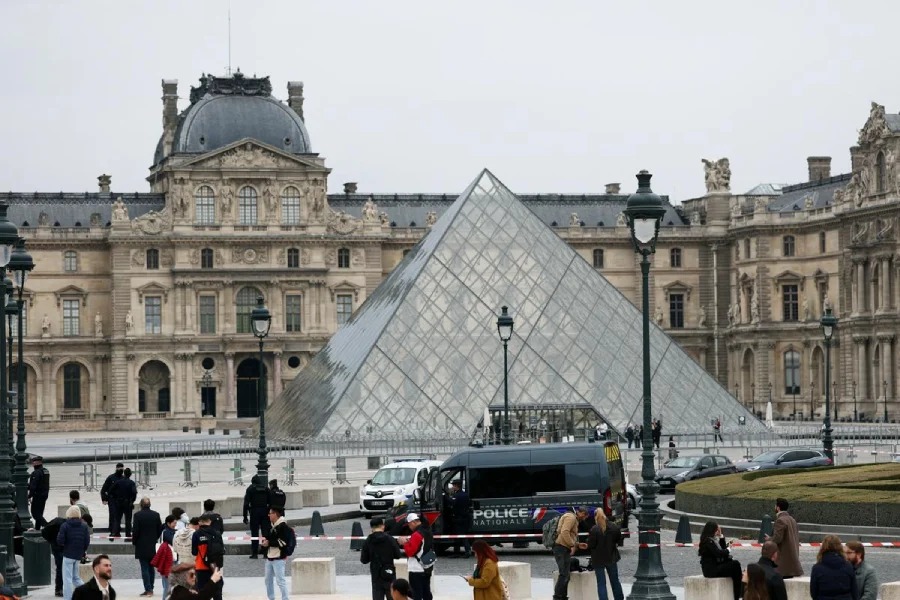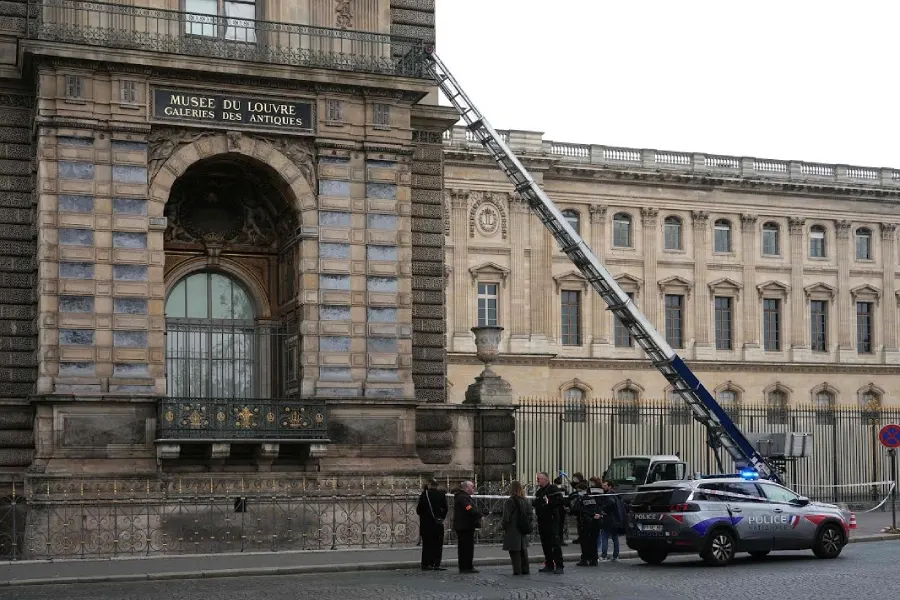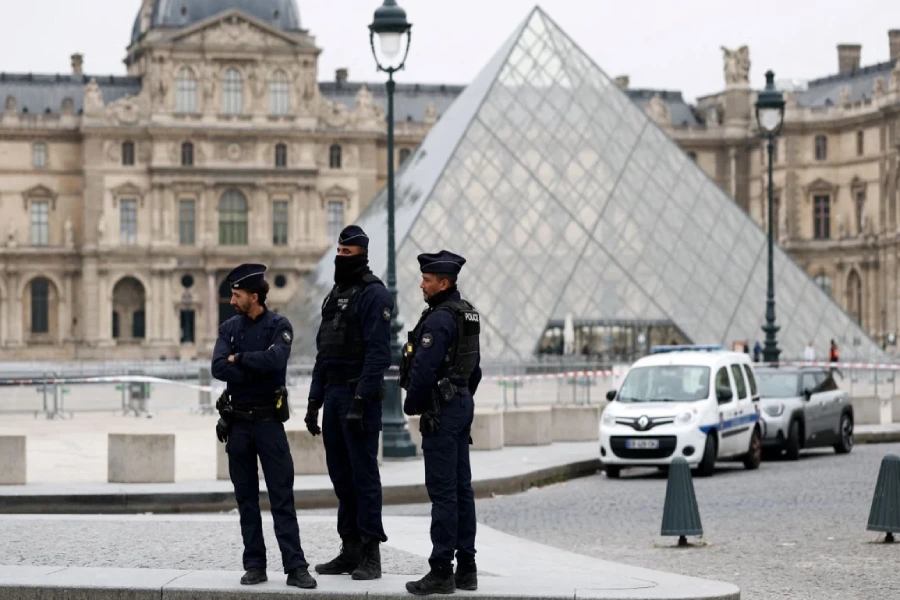The Louvre Museum a symbol of France’s artistic grandeur and the world’s most-visited museum became the scene of an audacious seven-minute robbery on October 19, 2025. In a meticulously coordinated operation, three or four masked thieves infiltrated the Galerie d’Apollon, home to the French Crown Jewels, and fled with nine pieces of priceless jewelry.
This shocking event has sparked not only a police investigation but also deep discussions among legal experts, architects, and cultural heritage scholars worldwide. Beyond its cinematic allure, the Louvre heist underscores vulnerabilities in heritage protection, architectural design, and international law.

Louvre Heist 2025: What Happened
According to reports from BBC, CNN, and Reuters, the thieves struck shortly after 9:30 a.m. local time, entering the museum through a side window overlooking the River Seine. They used a freight elevator mounted on a truck, combined with an extendable ladder, to reach the second-story window of the Galerie d’Apollon. Once inside, they smashed display cases with small chainsaws and seized jewelry of “incalculable cultural and historical value.”
Within seven minutes, the suspects escaped on motorbikes, disappearing into central Paris before police could respond. No injuries were reported among visitors or staff, but the museum immediately shut down for “exceptional reasons.”
| Detail | Description |
|---|---|
| Date | October 19, 2025 |
| Time of Entry | 9:30 a.m. (local time) |
| Location | Galerie d’Apollon, Louvre Museum, Paris |
| Duration | Approximately 7 minutes |
| Items Stolen | 9 pieces of Crown Jewels, including Napoleonic-era gems |
| Escape Method | Motorbikes via river-side exit |
| Injuries | None reported |
| Suspects | 3–4 masked individuals |
Architectural Weaknesses Behind the Louvre Heist
Despite its reputation for security and sophistication, the Louvre’s architecture—originally a royal palace built in the 16th century—proved to be a double-edged sword. The same design features that make the building a masterpiece of Renaissance architecture also render it vulnerable to modern threats.
Renovation work and temporary access structures, such as freight lifts and scaffolding, may have given thieves an opportunity to bypass alarms and guards. This has raised critical concerns in museum architecture circles about how heritage sites balance aesthetic authenticity with 21st-century security systems.
Experts suggest that the Louvre Heist 2025 could catalyze new standards for architectural surveillance—integrating AI-based motion sensors, facade-access monitoring, and digital visitor mapping in global museums.

Cultural Impact: A Blow to France’s National Heritage
The stolen jewels are not merely luxury items; they are symbols of French identity, representing centuries of monarchy, revolution, and art patronage. Among them are believed to be pieces connected to Napoleon III and Empress Eugénie, linking the theft to a formative period in French cultural history.
France’s Culture Minister Rachida Dati called the robbery “an attack on our collective heritage,” emphasizing that the items’ “inestimable historical and emotional value” far exceeds their market price.
The Louvre—already struggling with budgetary pressures for restoration and modernization—now faces global scrutiny over the safety of its 35,000 artworks, including Leonardo da Vinci’s Mona Lisa and Venus de Milo. The incident may accelerate state funding for security modernization under France’s Plan Patrimoine 2026.

Legal Dimensions of the Louvre Heist
1. French Legal Framework
Under the French Penal Code and Code du Patrimoine, theft of protected cultural property (biens culturels protégés) constitutes an “aggravated criminal offense”, punishable by up to 30 years imprisonment and heavy fines. The Paris Prosecutor’s Office has opened an investigation for “organized theft and criminal conspiracy.”
Moreover, civil claims may arise if investigations reveal negligence by museum contractors, particularly if scaffolding or maintenance work enabled access to restricted zones.
2. International Law and Cultural Property
The Louvre Heist 2025 also falls under the UNESCO 1970 Convention and the UNIDROIT 1995 Convention on Stolen or Illegally Exported Cultural Objects, both of which facilitate international cooperation for recovery of stolen art.
If the jewels cross EU borders, Interpol, Europol, and customs agencies will likely issue Red Notices to track and seize the artifacts. Given that art theft often involves complex laundering networks, recovery efforts may take years and span multiple jurisdictions.
3. Precedents and Accountability
Similar incidents, such as the Green Vault Heist (Dresden, 2019) and the Hatton Garden Robbery (London, 2015), reshaped how European courts view cultural theft. Legal scholars in Washington D.C. note that these events prompt broader questions about state liability, museum governance, and the legal definition of cultural negligence in public institutions.
Political and Economic Implications
The Louvre Heist has quickly become a symbolic issue in French politics. Opposition lawmakers argue that years of underfunding for cultural infrastructure created ideal conditions for the robbery. The government, meanwhile, promises a “national plan for cultural security.”
Economically, the Louvre’s temporary closure affects Paris tourism, which attracts 8.7 million visitors annually. The heist’s publicity might also impact insurance premiums for museums worldwide—especially those with high-value collections like the Smithsonian Institution in Washington D.C. or the British Museum in London.
Global Museum Lessons: From Paris to Washington D.C.
Cultural and legal observers in Washington D.C. are closely following the Louvre case, recognizing parallels with American museums housing priceless artifacts. The heist emphasizes the urgent need for:
-
Integration of cyber-physical security systems in heritage buildings.
-
Transparent emergency-response protocols and inter-agency coordination.
-
Legislative updates that classify cultural theft as transnational organized crime.
This event serves as a global warning that architectural beauty and accessibility must no longer outweigh legal compliance and digital-era protection.
FAQ
Q1: What was stolen from the Louvre in 2025?
A1: Nine pieces of priceless jewelry, part of the French Crown Jewels housed in the Galerie d’Apollon, were stolen during a seven-minute heist on October 19, 2025.
Q2: How did the thieves enter the Louvre?
A2: They used an external freight elevator mounted on a truck and a ladder to access a second-floor window near the Seine River façade.
Q3: What laws protect the stolen jewels?
A3: France’s Code du Patrimoine, the UNESCO 1970 Convention, and the UNIDROIT 1995 Convention protect cultural heritage from theft and illegal trade.
Q4: Were any visitors or staff harmed?
A4: No injuries were reported. The museum was evacuated as a precaution and closed for the day to preserve forensic evidence.
Q5: What will change after the Louvre heist?
A5: Museums worldwide will likely enhance physical and digital security, adopt stricter access policies during renovations, and reevaluate insurance and legal frameworks for cultural assets.
Conclusion
The Louvre Heist of 2025 is not merely a spectacular crime it is a defining moment in the intersection of law, architecture, and cultural preservation. It exposes the fragility of even the world’s most secure institutions and forces a reevaluation of how nations safeguard their heritage in a globalized, high-tech era.
As investigators continue to trace the stolen jewels, the Louvre stands as both a victim and a catalyst for reform one that may reshape international museum security and legal accountability for generations to come.

